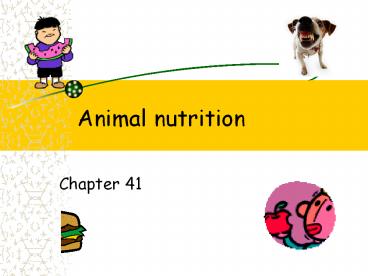Animal nutrition - PowerPoint PPT Presentation
Title:
Animal nutrition
Description:
Animal nutrition Chapter 41 Fig. 41-15b Microvilli (brush border) at apical (lumenal) surface Key Nutrient absorption Blood capillaries Epithelial cells Villi Lymph ... – PowerPoint PPT presentation
Number of Views:296
Avg rating:3.0/5.0
Title: Animal nutrition
1
Animal nutrition
- Chapter 41
2
(No Transcript)
3
Function
- 1. Digestion
- 2. Absorption of nutrients/water
- Energy
- Growth
- 3. Elimination
4
Heterotrophs
5
Intracellular digestion
6
Extracellular digestion
7
Extracellular digestion
8
Fig. 41-9
Crop
Gizzard
Intestine
Esophagus
Pharynx
Anus
Mouth
Typhlosole
Lumen of intestine
(a) Earthworm
Foregut
Midgut
Hindgut
Esophagus
Rectum
Anus
Crop
Mouth
Gastric cecae
(b) Grasshopper
Stomach
Gizzard
Intestine
Mouth
Esophagus
Crop
Anus
(c) Bird
9
Digestive system
10
General structure
- Gastrointestinal tract (tube)
- Mucosa inner layer (epithelial)
- Submucosa connective
- Muscularis 2 layers of muscle
- Serosa outer layer (connective)
- Plexues nerves located in the submucosa
11
Digestive organs
- Mouth
- Pharynx
- Esophagus
- Stomach
- Small intestine (duodenum, jejunum, ileum)
- Large intestine (cecum, ascending colon,
transverse colon, descending colon, sigmoid,
rectum, anus)
12
Digestive organs
- Accessory organs
- Liver
- Gallbladder
- Pancreas
13
Digestion
- Mouth
- Teeth
- Gizzard (in birds to help grind food)
- Salivary glands
- Secrete saliva
- Amylase (enzyme to breakdown starch)
14
Mouth
15
Salivary glands
16
Digestion
- Chew or mastication
- Tongue pushes food
- Pharynx
- Epiglottis closes
- Esophagus
17
Pharynx
18
Esophagus
- Esophagus
- Muscular tube
- Connects pharynx to stomach
- Peristalsis
- Rhythmic movement of muscle contractions
- Moves food along
- Esophageal sphincter
- End of esophagus keeps food in stomach
19
Stomach
- Mucosa lining (epithelial)
- Parietal cells
- Secrete H Cl ions
- Chief cells
- Secrete pepsinogen
- Pepsinogen is converted to pepsin
- Digests proteins
20
Stomach
- Gastric juices
- HCl, pepsinogen mucus pH2
- Chyme
- Mixture of partially digested food
21
Stomach
22
Stomach
23
Small intestine
- Chyme
- Leaves stomach via pyloric sphincter
- Duodenum
- Digestive enzymes from pancreas
- Bile from liver gallbladder
- Most digestion occurs in the duodenum jejunum
24
Intestines
25
Small intestine
26
Small intestines
- Villi along intestine epithelium
- Microvilli
- brush border
- Aids in absorption
- Secretes enzymes
- Break disaccharides (sucrose, lactose)
27
Small intestine
28
Accessory organs
29
Accessory organs
- Pancreas
- Secretes fluids via pancreatic duct
- Exocrine system
- Trypsin chymotrypsin (proteases)
- Amylase (starch)
- Lipase (fats)
- Bicarbonate (neutralizes HCl)
- Endocrine (insulin and glucagon)
30
Accessory organs
- Liver
- Secretes bile
- Contains bile pigments bile salts
- Bile pigments are waste from break down of RBC
- Eliminated
31
Accessory organs
- Bile salts
- Emulsify the fats
- Bile made in liver
- Stored in gall bladder
- Released when eat fatty meal
- Gallstones can block release
32
Small intestines
- Monosaccharides, aa are transported to the blood
capillaries - Hepatic portal vein
- Liver
- Heart
- Transported to body
33
Small intestines
- Fatty acids monoglycerides
- Villi
- Triglycerides
- Chylomicrons (triglyceride protein coat)
- Lymph system
34
Fig. 41-15b
Microvilli (brushborder) at apical(lumenal)
surface
Lumen
Bloodcapillaries
Epithelialcells
Basal surface
Epithelial cells
Lacteal
Lymphvessel
Villi
Key
Nutrientabsorption
35
Fig. 41-16
Triglycerides
Lumenof small intestine
Monoglycerides
Fatty acids
Epithelialcell
Triglycerides
Phospholipids,cholesterol,and proteins
Chylomicron
Lacteal
36
Essential nutrients
Carbohydrate digestion
Protein digestion
Nucleic acid digestion
Fat digestion
Oral cavity,pharynx,esophagus
Disaccharides
Polysaccharides
(starch, glycogen)
(sucrose, lactose)
Salivary amylase
Smaller polysaccharides,maltose
Stomach
Proteins
Pepsin
Small polypeptides
Lumen ofsmall intes-tine
DNA, RNA
Fat globules
Polysaccharides
Polypeptides
Pancreatic amylases
Pancreatic trypsin andchymotrypsin
Pancreatic nucleases
Bile salts
Maltose and otherdisaccharides
Fat droplets
Nucleotides
Smallerpolypeptides
Pancreatic lipase
Pancreatic carboxypeptidase
Glycerol, fattyacids, monoglycerides
Amino acids
Epitheliumof smallintestine(brushborder)
Small peptides
Nucleotidases
Nucleosides
Disaccharidases
Dipeptidases, carboxypeptidase,and aminopeptidase
Nucleosidasesandphosphatases
Nitrogenous bases,sugars, phosphates
Monosaccharides
Amino acids
37
Large intestines
- Absorbs water
- Absorbs vitamin K
- Concentrates wastes
- E. coli
- Feces
- Cloaca
- Combines feces urine wastes in some animals
38
Large intestine
39
Large intestine
40
Food
- BMR
- Basal metabolic rate
- Obesity
- Heart disease, diabetes, stroke
- Anorexia, Bulimia
41
Essential nutrients
- Essential aa
- Minerals
- Vitamins
- A, B-complex, C, D, E, K
- Scurvy, rickets, pernicious anemia, bleeding
42
Abnormalities
- Ulcers
- H. pylori
- Bacteria
- Treated with antibiotics
- Reflux
- Gastric juices go backwards to esophagus
43
Hiatal hernia
44
Volvulus
45
Intussusception
46
Pyloric Stenosis
47
Jaundice































